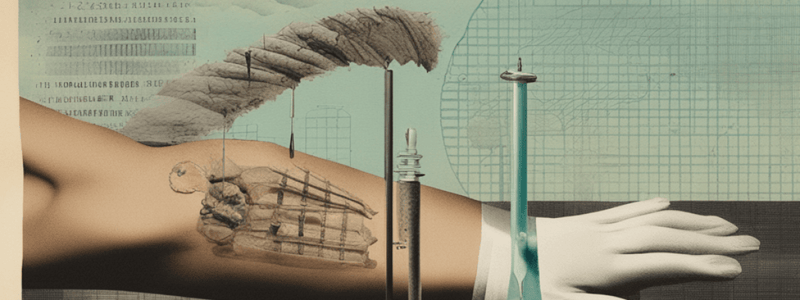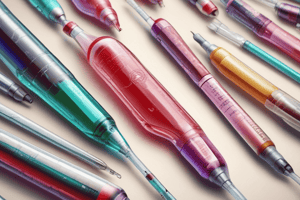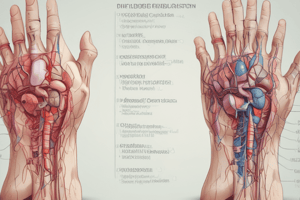Podcast
Questions and Answers
What is the advantage of using a butterfly for a hand draw?
What is the advantage of using a butterfly for a hand draw?
- Allows for a lower angle of insertion than a standard needle and tube holder (correct)
- Requires less control over suction for blood collection
- Provides faster blood collection from fragile veins
- Is only suitable for routine venipunctures
When using a WIS in the antecubital, what is the angle of insertion?
When using a WIS in the antecubital, what is the angle of insertion?
- 15-30 degrees (correct)
- 90 degrees
- 45-60 degrees
- 5-10 degrees
In which situation would a 23g WIS be commonly used?
In which situation would a 23g WIS be commonly used?
- For routine venipunctures in the antecubital
- For blood collection from large and sturdy veins
- For routine venipunctures in the back of the hand (correct)
- For blood collection from fragile veins on the back of the hand
Improper insertion or removal of the needle is the most common cause of hematoma.
Improper insertion or removal of the needle is the most common cause of hematoma.
Reflux of anticoagulant can occur when the tube contents come in contact with the stopper during the draw.
Reflux of anticoagulant can occur when the tube contents come in contact with the stopper during the draw.
The standard position for drawing blood from an outpatient is with the patient lying down.
The standard position for drawing blood from an outpatient is with the patient lying down.
What are the potential causes of occlusion and sclerosis in veins?
What are the potential causes of occlusion and sclerosis in veins?
How does a hematoma form and what impact does it have on blood flow?
How does a hematoma form and what impact does it have on blood flow?
What is edema and how does it affect test results?
What is edema and how does it affect test results?
What are the characteristics of occluded or sclerosed veins?
What are the characteristics of occluded or sclerosed veins?
How can a hematoma be caused during blood collection?
How can a hematoma be caused during blood collection?
Why is it important to minimize the amount of blood drawn from a patient?
Why is it important to minimize the amount of blood drawn from a patient?
Under what circumstances may it be appropriate to acquire blood with a dermal puncture instead of venipuncture?
Under what circumstances may it be appropriate to acquire blood with a dermal puncture instead of venipuncture?
What can excessive doses of anticoagulants or coagulation disorders, such as hemophilia, lead to during routine venipuncture?
What can excessive doses of anticoagulants or coagulation disorders, such as hemophilia, lead to during routine venipuncture?
What are the potential long-term complications associated with excessive removal of blood at the request of a physician?
What are the potential long-term complications associated with excessive removal of blood at the request of a physician?
What does compartment syndrome result in, if suspected in a patient?
What does compartment syndrome result in, if suspected in a patient?
How can you minimize the rolling of excessively rolling veins during venipuncture?
How can you minimize the rolling of excessively rolling veins during venipuncture?
What immediate steps should be taken if an artery is inadvertently punctured during blood collection?
What immediate steps should be taken if an artery is inadvertently punctured during blood collection?
What action should be taken after sample collection and needle withdrawal if an artery was inadvertently punctured?
What action should be taken after sample collection and needle withdrawal if an artery was inadvertently punctured?
Giving the patient an emesis basin and instructing them to breathe slowly and deeply can help prevent nausea and vomiting during a seizure.
Giving the patient an emesis basin and instructing them to breathe slowly and deeply can help prevent nausea and vomiting during a seizure.
Hematoma during venipuncture can be caused by excessive probing to obtain blood.
Hematoma during venipuncture can be caused by excessive probing to obtain blood.
Pain during venipuncture is commonly caused by insufficient depth of needle insertion into the vein.
Pain during venipuncture is commonly caused by insufficient depth of needle insertion into the vein.
Flashcards are hidden until you start studying




